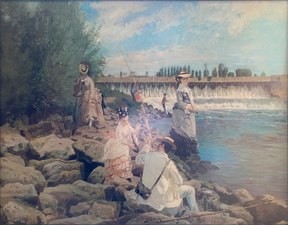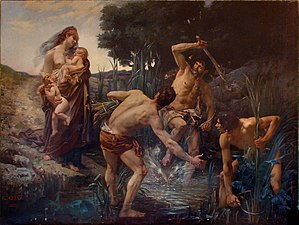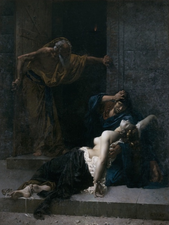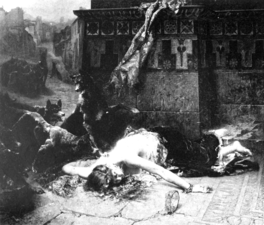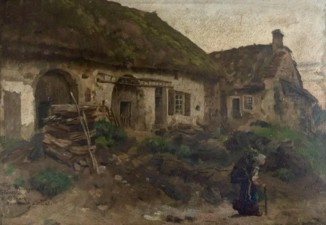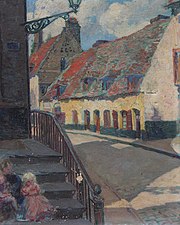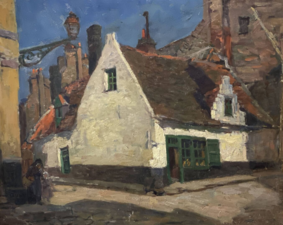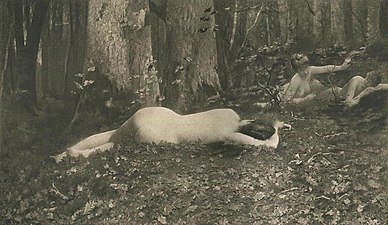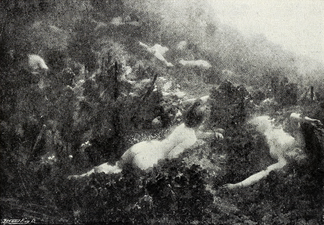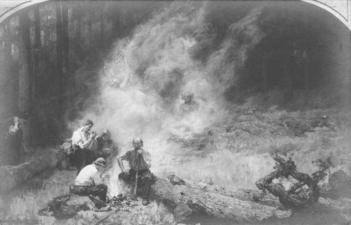|
Gabriel Guay
Gabriel Guay (October 14, 1848 – September 15, 1923), whose full name was Julien Gabriel Guay, was a French painter and teacher. From 1873 he exhibited works at the annual Paris Salon. He painted portraits, and also scenes inspired by literature, mythology, the Bible, and Christian martyrdom. His reverence for nature and especially for trees, combined with his affinity for the female nude, resulted in his most distinctive and widely exhibited paintings, depicting dryads in the woods. Personal life Guay was born in 1848 in a northern Parisian suburb, the village of La Chapelle; in 1859 it was incorporated into the 18th arrondissement of Paris. His parents were Jules Antoine Guay and Louise Joséphine Cottin. After his death in 1923 he was survived by his widow, Virginie Alexandrine Lequin.[2][3] His circle of friends included the artists Édouard Debat-Ponsan, Edmond Debon, Adrien Demont, Virginie Demont-Breton, Octave Jahyer, Henri Pille, Tony Robert-Fleury, and François Thévenot;[4] the painter Edmond Yon, in whose garden at Rue Lepic, n° 59, Guay painted nature studies;[5] and the author Léon Roger-Milès, who dedicated to Guay his story "Une Vision d'Allori", which imagines a dream of the Florentine painter Cristofano Allori as a starting point for a rapturous meditation on the transcendent beauty of the female nude.[6] The popular singer-comedian Ernest Gibert (who was to die in a spectacular accident a few weeks later)[7] entertained at an 1892 New Year's Eve party chez Guay.[8] One of Guay's paintings of a rustic farm house, in Vosges, is inscribed, "à Gibert, souvenir amical." Career Guay was a student of Justin Lequien and of Jean-Léon Gerôme, from whom he learned the exacting skills of French Academic painting. In 1873, at the age of 24, he had a painting accepted for exhibition at the annual Paris Salon, the traditional starting point for the career of a French artist of the 19th century; the work was Ulysse suspendu sur le gouffre de Charybde, inspired by a passage in Homer's Odyssey.[9] His Academic training is evident in his meticulously detailed and scrupulously finished early works which treat mythological and religious subjects, including Laton et le paysans (1877), Le Lévite d'Ephraim (1878), and Le Tullianum pendant la persécution; martyre de Sainte Pauline (1880).[9] By 1877 some of his paintings had made their way to San Francisco, where the art dealers Snow and May sold two of his works at auction, The Anglers and A Fishing Party.[10][11] Another work by Guay created a sensation in San Francisco at the 15th Mechanics' Fair of 1880.
On the day of the vote, 12,808 people bought tickets to the fair. The vote to unveil The Awakening prevailed in a landslide.[13] Guay's interest in the female nude, often seen from the back, continued throughout his career. Farniente (Lazing), from 1911, shows a sleeping nude, and in 1912, his submission to the Salon was simply titled Nu (Nude); both images were issued as souvenir postcards, presumably acceptable for delivery in the French post. The whereabouts of a number of his paintings are unknown. His Cosette of 1882, depicting the character from Les Misérables, is known today only from reproductions, one of which, an albumen print now at the Maison de Victor Hugo, he inscribed to the author: "A Victor Hugo, notre illustre poète national, Hommage de son grand admirateur, Gabriel Guay." His genre painting En l'absence du maître (While the Master's Away) of 1877 is also known only from reproductions, including a full-page engraving published in L'illustration: journal universel.[14]
At least one of his paintings is known to have been destroyed in the carnage of World War II: La mort de Jézabel, exhibited at the Salon of 1888, where it inspired the critic Henry Houssaye to write a vivid description:
The painting also caught the eye of Thomas Hardy, who wrote: "At the Salon. Was arrested by the sensational picture called The Death of Jezabel...a horrible tragedy, and justly so, telling its story in a flash."[16] Hardy scholar Dennis Taylor, trying to track down the painting almost a century later, was informed by René Le Bihan, curator of the Musée des Beaux-Arts de Brest, "Alas, this painting disappeared amid the annihilation of our museum in 1941, and we have no trace of it, not a photograph or engraving or drawing."[16] An image has since been located, in an issue of Firmin Javel's L'Art français from 1888. Guay painted portraits from the beginning of his career, and after the turn of the century the majority of paintings he exhibited at the Paris Salon were portraits. Of his portraits the only example we have is his painting of an old man in a garden (perhaps Guay's grandfather[9]), at the Musée des beaux-arts de Morlaix. Villages and farm housesWhile Guay's submissions to the Salon followed the rigorous standards of Academic art, and were sometimes quite large, he also painted a series of smaller works depicting rustic villages and farm houses in locations including Brittany and the Vosges region of France. Often executed in oil on panel, presumably painted en plein air, these display a looser, almost impressionistic brushwork, and may have been made as studies, souvenirs, and gifts. They are signed but not dated, making them difficult to place in the chronology of Guay's career. However, one of the paintings is inscribed, "Vosges, village de [uncertain], à Gibert, souvenir amical." If the recipient was the singer-comedian Ernest Gibert (who was a friend of Guay), a terminus ante quem of 1893 for the painting can be established by the death of Gibert in March of that year.[7][8]
DryadsIt was in his paintings of forests and dryads that Guay most distinctly expressed his artistic vision and most successfully struck a chord with popular taste and critical reception; "his talent was transformed in the attentive study of nature."[9] Guay was inspired by the female tree spirits of Greek mythology, and also by a centuries-old current in French literature that perceived a mystical or spiritual power in trees and lamented the felling of a tree as a kind of murder. Guay's dryad series began with Poème des bois, which became his most widely exhibited picture. It was shown at the Paris Salon of 1889, where it received a silver medal; at the Exposition Universelle of 1900 in Paris, where it received another silver medal; and at the Franco-British Exhibition of 1908 in London. The conception was simple: a number of nude women lie amid fallen leaves in an autumnal forest. An ethereal light introduces a note of the uncanny. The painting was purchased by the French State and deposited at the Musée de Draguinan. Its present location is unknown and the image is known only from reproductions. La mort du chêne (The Death of the Oak) followed in 1891, inspired by a poem by Victor de Laprade: "When the man struck you with his cowardly ax,/O king whom the mountain yesterday carried with pride,/My soul, at the first blow, resounded with indignation,/And in the holy forest there was great mourning…"[17][18] The location of the painting is unknown. La dernière dryade appeared in 1898. It is the best-known of Guay's works, having survived intact in the collection of the Musée des Augustins de Toulouse. The painting was inspired by a poem by Émile Blémont: "A mournful silence filled the great woods,/Once peopled with such sweet visions./Pan had just expired. 'Fall, O red leaves!/Fall!' cried the weeping Dryad in a dying voice." The faded Greek letters on the pedestal translate: "Pan, beloved of the amorous Dryads."[19] The critic Antonin Proust wrote, "The impression is so truthful, the autumn feeling is so tangible, that we can but feel grateful to M. Guay for so successfully bringing before us a thing we have so often seen."[20]
Les grives (The Thrushes) was exhibited at the Paris Salon of 1899. It was shown again at the Exposition Universelle of 1900, along with Poème des bois. Here the dryads, like hungry thrushes, are entwined amid grape vines, shimmering with dew and the blood-red juice of crushed grapes ("du sang des grappes écrasées" according to the uncredited verses in the Salon program).[21] The critic Camille Le Senne praised its "rare luminous qualities" and "undeniable poetic charm."[22] The painting is now known only from poor reproductions. Guay's dryad series culminated with Les bourreaux des bois (Executioners of the Woods), again inspired by a poem, this one very old: "Contre les bûcherons de la forêt de Gastine" (Against the Lumberjacks of the Forest of Gastine) by Pierre de Ronsard (1524-1585). (Another inspiration may have been the poem "Pour les Arbres" by François Fabié, published in 1906, which cites Ronsard and uses the phrase "les bourreaux des bois".[23]) The painting was exhibited twice at the Paris Salon, in 1909 and again in 1914, on the eve of World War I. One reviewer called it
The English critic Henry Heathcote Statham, perhaps noting the demonic appearance of one figure in the smoke, perceived a note of menace, saying "the woodcutters felling trees are threatened with vengeance by an apparition of nymphs."[25] The poem by Ronsard is a lament, but also calls for harsh justice: "Murderous sacrilege! If we hang a thief/For plundering booty of very little value,/How many fires, irons, deaths and distress/Do you deserve, villain, for killing our goddesses?" Depicting women and trees, Guay could also display a sense of humor. The undated work La Couture presents a domesticated dryad; a very real woman, not naked but entirely clothed, is perched on the stump of a tree not unlike a pedestal, content to sew. The undated study Amour! depicts a nude Aphrodite in the forest, seated on a felled tree. Bald acolytes tend a wood-burning fire at her feet. LegacyThe year after his death, the Paris Salon of 1924 acknowledged Guay's passing with a retrospective of his work at the Grand Palais.[26] Along with painting, Guay was also a teacher, serving as a professor of drawing at the Ecole Municipale Supérieure Turgot from at least 1898 to 1912.[9][27][28] Some of his students also became students of Jean-Léon Gerôme, Guay's own mentor. After Gerôme's death in 1904, Guay carried forward the principles of Academic art into the 20th century, even as it faded from fashion, a once mighty forest felled by Impressionism. In museums and other buildings Guay's works in museums, listed in chronological order, include:
References
Sources
External linksWikimedia Commons has media related to Gabriel Guay.
|
||||||||||||||
Portal di Ensiklopedia Dunia

